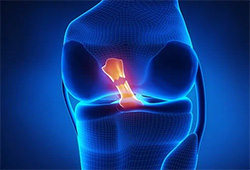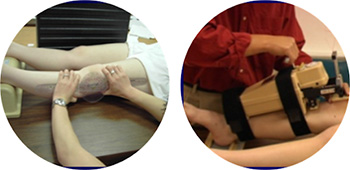
Overview
The Anterior Cruciate Ligament (ACL) is the primary stabilizing ligament in the knee. Females are 2-3 times more likely to suffer an anterior cruciate ligament injury compared to similarly trained males in sports that involve landing, cutting and quick change of direction. Our research efforts focus on understanding of the key risk factors for ACL injury in females, developing evidence-based screening tools to identify those at risk, and designing therapeutic interventions that have the potential to increase ACL resiliency and the ability to withstand external loading during sport activity. We are particularly focused on the adolescent female — 
ACL Risk Development in the Adolescent Female
Treatment costs for pediatric ACL injury are estimated to exceed $1.3 billion annually. ACL injuries are rare before the age of 12, then rise rapidly and peak between 14-17 years of age, with females ultimately developing a 3.1- to 4.1 greater relative risk than similarly trained males. Adolescent females who suffer ACL injury are more likely than adolescent males or adults to suffer secondary health consequences, including a 2nd ACL injury, early-onset osteoarthritis, and reduced quality of life. Despite the evidence, less than 15% of published research on ACL injury risk and prevention has focused on the adolescent population.
Our overarching research agenda is to 1) understand the critical impact that rapid changes in hormones and body composition (both fat mass and fat free mass) have on ligament development and resiliency (size and quality) during the years when ACL risk is rapidly rising and peaks in adolescent females, and 2) how timing (age of onset) and tempo (rate of progression) of pubertal development impacts these relationships.
To that end, we are currently pursuing four independent yet complimentary areas of research:
- Identify the maturity status at the time of ACL injury
- Identify the developmental factors leading to inferior muscle and ligament size and quality
- Evaluate the feasibility of a strength training intervention to optimize muscle development and increase ACL resiliency
- Identify clinical accessible screening tools to assess ACL resiliency
Maturity Status at the Time of ACL Injury
Understanding how ACL injury risk changes relative to pubertal milestones is important, as maturity stage, not age, drives the sex-specific development of biological and physical characteristics associated with the higher risk of ACL injury in females (e.g., hormones, joint laxity, body composition, ACL size, and lower extremity movement patterns). We are currently partnering with orthopedic clinics to conduct a multi-center pilot study to assess the stage of pubertal development and skeletal growth at the time of pediatric ACL injury. These findings will compliment a recent systematic review and meta-analysis (Shultz et al, Journal of Athletic Training, 2023; doi: 10.4085/1062-6050-0038.22) that examined the sex- specific trajectories in physical risk factors with pubertal growth.
Lead Investigators: Sandy Shultz, Randy Schmitz and Justin Fegley.
Collaborators: Moses Cone Sports Medicine, Murphy Wainer Orthopaedic Specialists, Wake Forest University Department of Orthopaedic Surgery, Hospital for Special Surgery Department of Orthopaedics and Women’s Sports Medicine Center, Children’s Hospital of Philadelphia Division of Orthopaedics, University of Missouri-Columbia Department of Orthopaedic Surgery
Developmental Factors that Lead to Inferior Muscle and Ligament Size and Quality
Body Mass Index (BMI; weight by stature) is a modifiable risk factor consistently linked with a greater risk of knee sprains, and specifically ACL injuries. BMI is one of the strongest predictors of ACL risk in females, but not males, and risk increases substantially when high BMI is present with other known risk factors (e.g., greater knee laxity). Despite this evidence, there is a paucity of research examining how BMI contributes to non-contact ACL injury risk in females. Importantly, BMI is not an ideal metric of body composition because it does not discern fat mass from fat free-mass contributions to weight by stature.
Our goal is to use a longitudinal perspective to elucidate the underlying pathways through which body composition (specifically greater fat mass) harms muscle and ligament development in adolescent girls, thereby increasing their risk for ACL injury.
Lead Investigators: Sandy Shultz
Collaborators: Dr. Ellen Casey (Hospital for Special Surgery), Dr. Olga Gupta (Duke University), Jessica Dollar, Randy Schmitz, Lenka Shriver, Jianping Sun, Laurie Wideman
Healthy Girls Initiative
The Healthy Girls Initiative is an interdisciplinary team of investigators with expertise in developmental processes and mental and physical health outcomes. Our aim is to capture the complexity of the pubertal processes that characterize normative vs. risk development in adolescent girls and determine suitable entry points for mitigating the negative mental and physical health outcomes that reduce quality of life and lead to illness, injury and disease across the lifespan. One aspect of this initiative is to understand the developmental processes that contribute to known physical risk factors for ACL injury in adolescent females (e.g., hormone exposure, higher BMI, greater knee laxity) and determine the best time to intervene on that risk.
Lead Investigators for Physical Health Outcomes: Laurie Wideman and Sandy Shultz.
Collaborators: Robin Bartlett, Daniel Beavers, Susan Calkins, Sandra Eccheveria, Lenka Shriver, Jessica Dollar and Joseph Skelton, MD.
REP-ACL
There is increasing evidence that females develop smaller ACLs than males (even once accounting for body size), and that smaller ACLs are associated with a greater risk of ACL injury. These differences emerge during maturation, about the same time that sex differences in body composition (with females developing more relative fat mass and less muscle mass compared to males) and ACL injury risk emerge.
Recently, our research has revealed that muscle mass is a stronger determinant of ACL size than other body dimensions, and that in turn, ACL size is a strong determinant of anterior knee laxity. We are currently exploring the potential for a resistance exercise program initiated early in the maturation process to augment muscle development and increase ACL size and resiliency in a young female.
Lead Investigator: Sandy Shultz.
Collaborators: Randy Schmitz, Laurie Wideman, John Cone, Jackie Maher and Lenka Shriver.
The Role of Knee Joint Laxity in the ACL Injury Risk Equation
A primary area of study has been to understand the role of knee joint laxity in a female’s increased susceptibility for knee joint trauma. Knee joint laxity defines the ‘looseness’ of the knee joint, or how much the joint displaces under a specific load. As females mature, they develop greater knee joint laxity than males, and greater knee joint laxity has consistently been identified as a risk factor for ACL injury.
Over the past 20 years, we have examined the genetic, anatomical and hormonal factors that precipitate greater knee laxity profiles in women. We have also sought to understand the mechanistic link between greater knee laxity and risk of ACL injury.
Key Research Findings
For more information, see our list of publications.
- Knee laxity has since been identified in large multivariate risk factor studies to be among the strongest independent predictors of ACL injury risk in females.
- Sex differences develop during the maturational process, and can be as much as 25-30% greater in females compared to males by late adolescence, early adulthood.
- In addition to having greater baseline knee laxity than males, females also experience acute changes in knee laxity during exercise and with acute changes in hormone concentrations across the menstrual cycle.
- Females with greater knee laxity (both baseline and acute increases across the menstrual cycle and during exercise) are more likely to display the higher risk biomechanics that are thought to place a female at greater risk for ACL injury.
- Genetics, sex-specific hormone profiles and anatomy all contribute to these greater knee laxity profiles in females.
Development of a Multi-Axial Joint Laxity Testing Apparatus
There are many clinical uses for measuring knee laxity. In the absence of injury, measuring knee laxity can identify those who may be at greater risk for future knee joint injury, and enable timely and effective interventions to mitigate risk before injury occurs. When injury does occur, knee laxity testing can assist with accurate diagnosis of ligament injuries, assessment of ligament integrity post-surgery and during the healing / rehabilitation process, and objective monitoring of joint health over time.
Our team is developing a commercially viable and clinically friendly instrumented knee arthrometer that accurately measures knee laxity in 3 planes of motion in 5 minutes or less with limited training. In prior funded work, we developed the mechanical aspects of the prototype. We are currently integrating a precision measurement system into the device.
Lean Investigators: Sandy Shultz and Randy Schmitz.
Co-Investigators: Kenneth Cameron, Minjeong Kim, Robert Koshinskie, Michael Marshall and Jeffrey Taylor.
Funding: North Carolina Biotechnology Center Translational Research Grant.
Development of a Dynamic Knee Support for Prevention of Knee Injuries
Knee injuries account for ~50% of all acute musculoskeletal injuries in physically active and military personnel and can result in substantial health care costs and reduced quality of life. Individuals (particularly young females) who have greater knee joint laxity have more difficulty in stabilizing the knee during sport activity and have a greater risk of knee ligament injury. Thus, therapeutic interventions that enhance functional joint stability in those with excessive joint laxity are critically needed from both an injury prevention and rehabilitation standpoint.
The proposed innovation is intended to fulfill this critical need by designing an external knee support to enhance joint protection and ensure safe motion limits are not exceeded during physical activity.
Lean Investigators: Sandy Shultz, Randy Schmitz and Dennis LaJeunesse.
Co-Investigators: Beth Bacon, Hunter Holden and Robert Koshinskie.
Funding: National Science Foundation I-Corps Program.
Funding Sources
We are grateful for the funding sources that have supported this research agenda.
